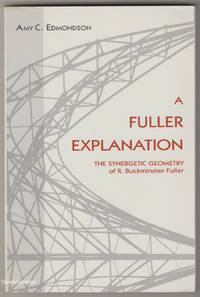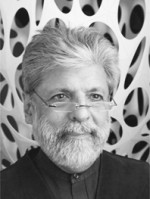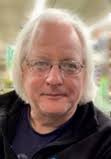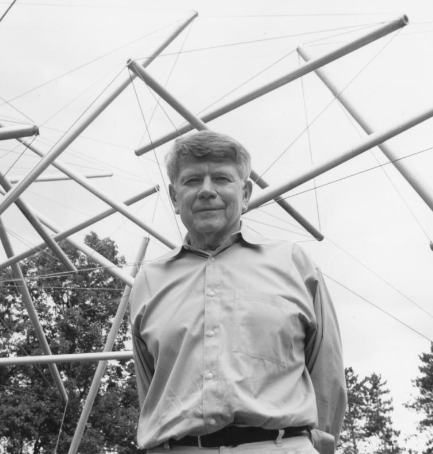Bonnie DeVarco

“Ed Popko & Christopher Kitrick’s newly revised and updated edition of Popko’s book, Divided Spheres is a marvelously detailed homage to the geometry of the sphere and spherical polyhedra. The field has grown significantly since 2012 when the original book was published. This new edition elevates Divided Spheres as the definitive resource for the history of 20th century breakthroughs in geodesics by two practitioners who are part of that history. Full color computer generated images and excellent writings by Kitrick introduce fresh and unique approaches. The eloquent foreword by geodesics expert Joseph Clinton clarifies how designers, students, scholars or practitioners of any discipline can take their own pathways through the voluminous material in the book to find value and insights along the way. It also serves as a comprehensive handbook featuring a range of techniques for tessellating the sphere.”
Author of Invisible Architecture, former Chief Archivist at the Buckminster Fuller Institute and artisan of collaborative virtual environments and visual languages.
Amy C. Edmondson, PhD

“Divided Spheres is simply a tour de force. The book’s comprehensive coverage and clear, elegant writing are remarkable, and it is enhanced by compelling figures throughout the text. Popko and Kitrick have managed to make three-dimensional geometry accessible without oversimplifying their material.” Author of A Fuller Explanation: The Synergetic Geometry of Buckminster Fuller, Professor, Harvard Business School
George Hart – Mathematician and Sculptor

“Divided Spheres presents a wealth of ideas and images for anyone interested in spherical constructions. The section on the history of geodesic dome design and the chapter with new material on rotegrities and nexorades are particularly notable. Popko’s book is sure to spark the creative juices of readers who love geometry and who think about making physical spherical structures.”
Haresh Lalvani, Architecture Professor, Pratt Institute

“This is an exceptionally well-produced book on spherical subdivisions with beautiful, colored illustrations, all digital. This book is on a topic of continuing interest despite its long history, and it always brings new surprises like that gem on ‘self-organizing grids’ included in this edition. Ideas, old and new, are collected in this careful methodical work which brings together the history and advancement of spherical structures and their implications across different fields. It is written by two expert practitioners from the early pioneering days of the field. Their treatise is a reminder that rigor, depth and beauty go hand in hand, and are a requirement for lasting works like this.” Photo faculty directory, Pratt Institute.
Daniel Lopez-Perez, Associate Professor of Architecture at the University of San Diego

“Edward Popko and Christopher Kitrick’s Divided Spheres unfolds the Orderly Subdivision of the Sphere into a comprehensive and growing survey of the historical, spherical, polyhedral, mathematical and material patterns inherent in such a universal question. A fundamental resource for anyone interested in exploring the order, and part-to-whole relationships of any formal system in design.” Author of R. Buckminster Fuller, Pattern-Thinking
Koji Miyazaki – Author of The Japanese Encyclopedia of Polygons, Polyhedra and Polytopes
 If the sphere is sometimes said to be the sovereign of the kingdom of geometric shapes, then this book could rightly be said to be the complete chronicle of its many deeds. Its contents will undoubtedly be quoted and used by scientists and artists the World over – including Japanese researchers or creators of traditional spherical artifacts such as Temari balls or Origami polyhedra – thanks to the crystal-clear accessibility of its explanations and the wonderful accompanying graphics, which overcome even the steepest language barriers.
If the sphere is sometimes said to be the sovereign of the kingdom of geometric shapes, then this book could rightly be said to be the complete chronicle of its many deeds. Its contents will undoubtedly be quoted and used by scientists and artists the World over – including Japanese researchers or creators of traditional spherical artifacts such as Temari balls or Origami polyhedra – thanks to the crystal-clear accessibility of its explanations and the wonderful accompanying graphics, which overcome even the steepest language barriers.
Tarnai Tibor – Professor Emeritus at Budapest University of Technology and Economics

“Divided Spheres is about spherical subdivision techniques and their applications. It provides an authentic description of the results of Buckminster Fuller and his circle in this field, but beyond geodesic domes, it discusses several old and new practical applications in cartography, astronomy, virus research, dimple patterns of golf balls, fish farming and in many more subjects. Important geometrical problems related to spherical subdivision such as spherical circle packings and coverings, as well as polyhedra with extremal properties are also treated. It contains a detailed mathematical description of effective subdivision methods according to which the reader can execute calculations and determine the data of his/her geodesic network. The book is well written and beautifully illustrated and can be read by specialists and general readers alike.”
Kirby Urner – Educator, Computer Scientist and Synergetics Activist

“I value Divided Spheres highly, as a pithy primer for anyone wishing a fresh approach to spherical geometry, and to geometry in general. As a curriculum developer, I include it in any syllabus that also includes R. Buckminster Fuller’s Synergetics, as a complementary and enlightening investigation. The pattern language of spheres comes through loud and clear in this book.”
Praise for the previous edition
Shoji Sadao – Architect, Cartographer and lifelong business partner of Buckminster Fuller
 Ed Popko’s comprehensive survey of the history, literature, geometric and mathematical properties of the sphere is the definitive work on the subject. His masterful and thorough investigation of every aspect is covered with sensitivity and intelligence. This book should be in the library of anyone interested in the orderly subdivision of the sphere. Photo by Metalocus.
Ed Popko’s comprehensive survey of the history, literature, geometric and mathematical properties of the sphere is the definitive work on the subject. His masterful and thorough investigation of every aspect is covered with sensitivity and intelligence. This book should be in the library of anyone interested in the orderly subdivision of the sphere. Photo by Metalocus.
Kenneth Snelson – Tensegrity Sculptor and Photographer
 Edward Popko’s Divided Spheres is the definitive source for the many varied ways a sphere can be divided and subdivided. From domes and pollen grains to golf balls,every category and type is elegantly described in these pages. The mathematics and the images together amount to a marvelous collection, one of those rare works that will be on the bookshelf of anyone with an interest in the wonders of geometry. Kenneth Snelson with Free Ride Home, Storm King Art Center, New York. Photo by Michael Nelson
Edward Popko’s Divided Spheres is the definitive source for the many varied ways a sphere can be divided and subdivided. From domes and pollen grains to golf balls,every category and type is elegantly described in these pages. The mathematics and the images together amount to a marvelous collection, one of those rare works that will be on the bookshelf of anyone with an interest in the wonders of geometry. Kenneth Snelson with Free Ride Home, Storm King Art Center, New York. Photo by Michael Nelson
Steve Waterman – Mathematician
 My own discovery, Waterman Polyhedra, was my way to see hidden patterns in ordered points in space. Ed’s book, Divided Spheres, is about patterns and points too but on spheres. He shows you how to solve practical design problems based on spherical polyhedra. Novices and experts will understand the challenges and classic techniques of spherical design just by looking at the many beautiful illustrations.
My own discovery, Waterman Polyhedra, was my way to see hidden patterns in ordered points in space. Ed’s book, Divided Spheres, is about patterns and points too but on spheres. He shows you how to solve practical design problems based on spherical polyhedra. Novices and experts will understand the challenges and classic techniques of spherical design just by looking at the many beautiful illustrations.
Magnus Wenninger – Benedictine Monk and Polyhedral Modeler
 I have loved the beauty and symmetry of polyhedra and spherical divisions for many years. My own efforts have been concentrated on making both simple and complex spherical models using classical methods and simple tools. Dr. Popko’s elegant new book, Divided Spheres, extends both the science and the art of spherical modeling to include Computer-Aided Design and applications, which I would never have imagined when I started down this fascinating and rewarding path.
I have loved the beauty and symmetry of polyhedra and spherical divisions for many years. My own efforts have been concentrated on making both simple and complex spherical models using classical methods and simple tools. Dr. Popko’s elegant new book, Divided Spheres, extends both the science and the art of spherical modeling to include Computer-Aided Design and applications, which I would never have imagined when I started down this fascinating and rewarding path.
His lovely illustrations bring the subject to life for all readers, including those who are not drawn to the mathematics. This book demonstrates the scope, beauty and utility of an art and science with roots in antiquity. Spherical subdivision is relevant today and useful for the future. Anyone with an interest in the geometry of spheres, whether a professional engineer, an architect or product designer, a student, a teacher, or simply someone curious about the spectrum of topics to be found in this book, will find it helpful and rewarding. Photo by Edward Popko.
Thomas T. K. Zung – Senior Partner, Buckminster Fuller, Sadao & Zung Architects.
 Edward Popko’s Divided Spheres is a ‘thesaurus’ must to those whose academic interest in the world of geometry looks to greater coverage of synonyms and antonyms of this beautiful shape we call a sphere. The late Buckminster Fuller might well place this manuscript as an all reference for illumination to one of nature’s most perfect inventions. Author of Buckminster Fuller: Anthology for the New Millennium.
Edward Popko’s Divided Spheres is a ‘thesaurus’ must to those whose academic interest in the world of geometry looks to greater coverage of synonyms and antonyms of this beautiful shape we call a sphere. The late Buckminster Fuller might well place this manuscript as an all reference for illumination to one of nature’s most perfect inventions. Author of Buckminster Fuller: Anthology for the New Millennium.
